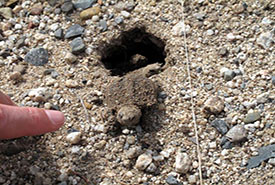Musquodoboit River

Hatching turtle along the Musquodoboit River (Photo by NCC)
In the summer of 2017, the Nature Conservancy of Canada (NCC) announced the addition of two new conservation projects on the lower Musquodoboit River, near Musquodoboit Harbour. The new properties feature an additional 67 hectares (166 acres) of conserved land. These conserved lands provide important habitat for several species of at-risk turtles and migratory birds.
NCC now protects 214 hectares (528 acres) on the Musquodoboit River with older hemlock forests on steep, mossy hillsides. The river's intact floodplains feature a rare combination of black cherry and red oak trees. NCC's nature reserves are located in one of the most untouched sections of the Musquodoboit River.
The Musquodoboit River properties were protected with the following support:
- Government of Canada - Natural Area Conservation Program
- North American Wetlands Conservation Agreement (NAWCA)
- Nova Scotia Crown Share Land Legacy Trust
- Halifax Regional Municipality/Community Grants Fund
- Nova Scotia Habitat Conservation Fund
- Nova Scotia Habitat Conservation Fund (contributions from hunters and trappers)
- and many local donors and supporters
The area conserved by NCC on the Musquodoboit River connects to Nova Scotia’s White Lake and Ship Harbour-Long Lake Wilderness Areas. These conserved lands create an extensive corridor ideal for wildlife. The well-maintained Musquodoboit Trailway crosses the property, making it an accessible wilderness for hikers and cyclists. Along with these upstream properties, NCC has now conserved more than 610 hectares (1,500 acres) in the Musquodoboit Harbour area for wildlife habitat and for people to enjoy.




